Studio Visit
L.A. Artist Craig Kucia Paints Curious Contraptions That Defy Logic
The artist's New York debut, "Machines to Solve Unsolvable Problems," is on view at Shrine through December 9.
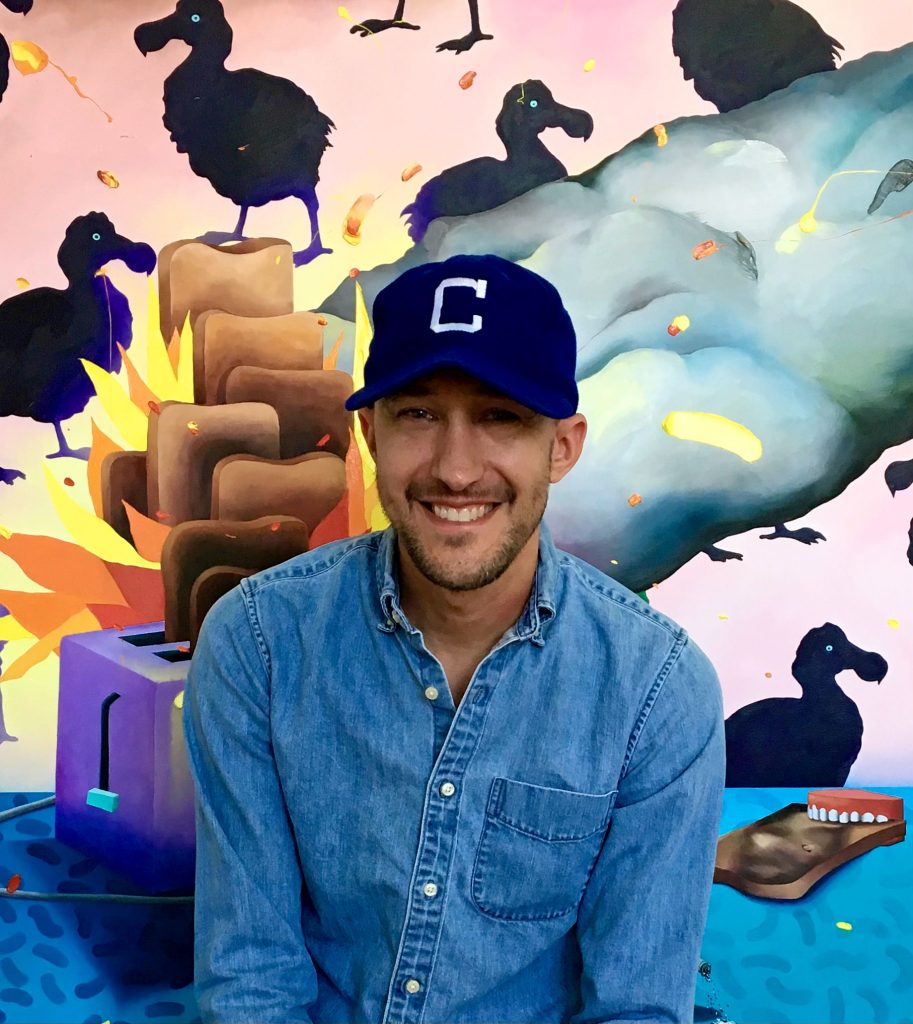
The artist's New York debut, "Machines to Solve Unsolvable Problems," is on view at Shrine through December 9.

Katie White

Los Angeles artist Craig Kucia paints idiosyncratic and imaginary machines, tailor-made to solve all our prickliest dilemmas.
The artist’s New York solo debut “Machines to Solve Unsolvable Problems” at Shrine in Tribeca (open through December 9), presents his newest whimsical compositions, paintings that conjure up Rube Goldberg-like mechanisms and promise to alleviate social anxieties, solve the riddle of keeping pet dogs alive forever, and more.
Chock-a-block with levers and wheels, bright colors, and winking humor, these machines are a veritable Seussian world for adults, teetering precipitously near collapse, yet remaining hopeful. In one painting, dozens of cameras, seemingly plucked from every era of the medium’s history, are gathered precariously atop a mix of branches, like all-seeing nests. In another, a wooden hand, suspended from an unseen ceiling, grasps paintbrushes and mechanically marks paint onto a canvas—a fix for the often tedious work of painting.
Kucia (b. 1975), who was raised in Cleveland, Ohio, brings a working-class resiliency to these paintings, a desire to tinker and problem-solve the often amorphous and looming worries of contemporary American life, the same way others might tune up a car. In recent years, the artist has earned recognition for his dazzlingly colorful paintings of whales, striking scenes inspired by the personal tragedies of those who worked in the whaling industry. His newest works, however, return to earlier interests in his career and are energetic, apparatus-filled, and boldly optimistic.
The artist makes these works in a single-car garage at the Los Angeles home he shares with his partner, the curator and art advisor Thea Smolinski, and their two daughters, Ruby and Archie. Recently we caught up with Kucia, who told us about managing his studio days to make bedtime rounds, why he paints without any chemicals, and would never be caught wearing Crocs.
Tell us about your studio. Where is it, how did you find it, what kind of space is it, etc.?
My studio is in my house. We moved during the pandemic and could afford to upgrade our living space a bit if we folded in the cost of my studio. It’s a single-car garage, underneath our house. We drywalled it and it has big old-fashioned doors that swing out.
How does your studio space affect your work?
When we lived in Hollywood, my studio was downtown and the traffic was insane. I had to plan everything around the Dodgers’ schedule. We’ve got two kids now and I just don’t have time to factor in that kind of commute. It also means that my partner, Thea, and our girls are in and out of the space all day, and I can come up for dinner or bedtime and then go back down, which is great on a deadline.
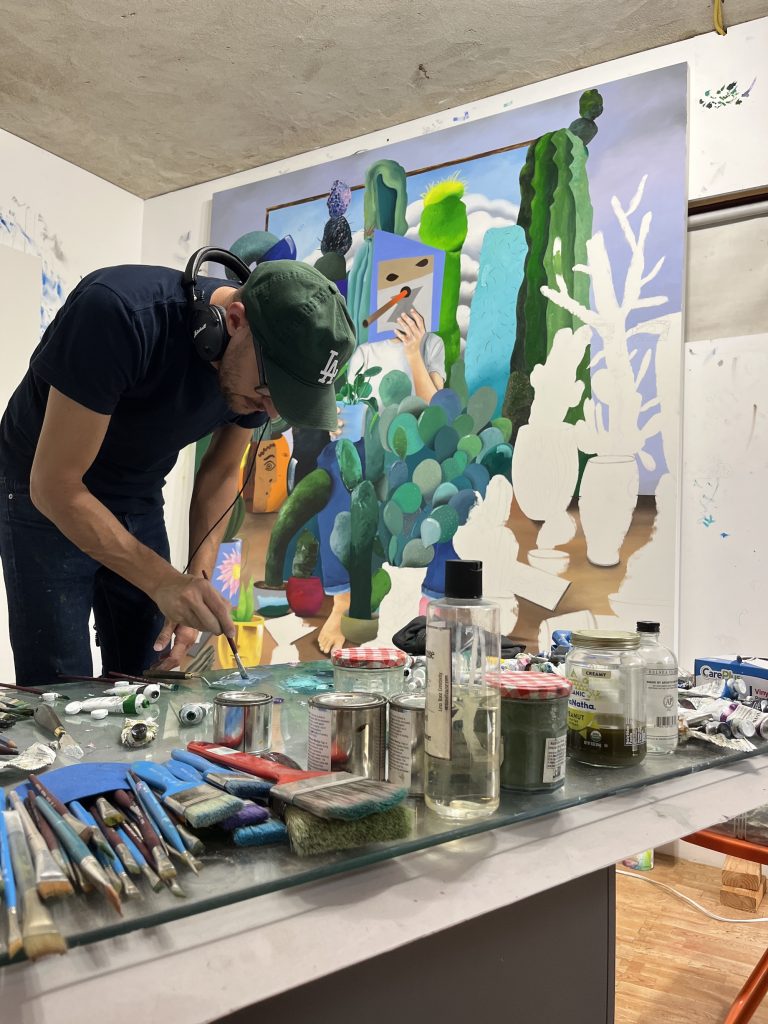
Craig Kucia in his studio. Courtesy of the artist.
Tell us about your new show at Shrine in Tribeca—it’s your debut solo exhibition in New York. How are the works in keeping with your oeuvre? How are they different? What are your primary inspirations?
This show feels like a return to work I was making early on. They’re larger and more complex. I use the idea of narratives, but I don’t think of them as stories per se. A newer audience found me through the whales, so this might feel like a departure, but it’s really a continuation of what I’ve always been doing. I think it’s more personal, but also a lot more focused.
I’d say my primary inspirations are class and the memory of experience. I grew up pretty working class, and there are touchstones of that specifically that I want to represent in a way that celebrates—you’ll see a lot of that in the machines. My dad and grandpa were mechanical and could fix or build anything out of anything. But I also want to talk about a larger experience of class. I think a lot of people don’t know that that’s what the whales were about—the social microcosm of a whaling ship and the way so many of those tensions and interactions ended in tragedy.
How many hours do you typically spend in the studio, what time of day do you feel most productive, and what activities fill the majority of that time?
I’m in the studio anywhere from 6 to 12 hours a day depending on deadlines, but it also definitely feels like that part of my brain never really turns off. The girls go to school at 8 in the morning, so I usually get in there around 9. There’s a lot of mental preparation to start painting that I think Thea would classify as “just sitting.” But then once I get down to it, I’m pretty full-on. I used to be most productive late at night, but I can’t do that anymore. We live in California, so that afternoon light is pretty great.
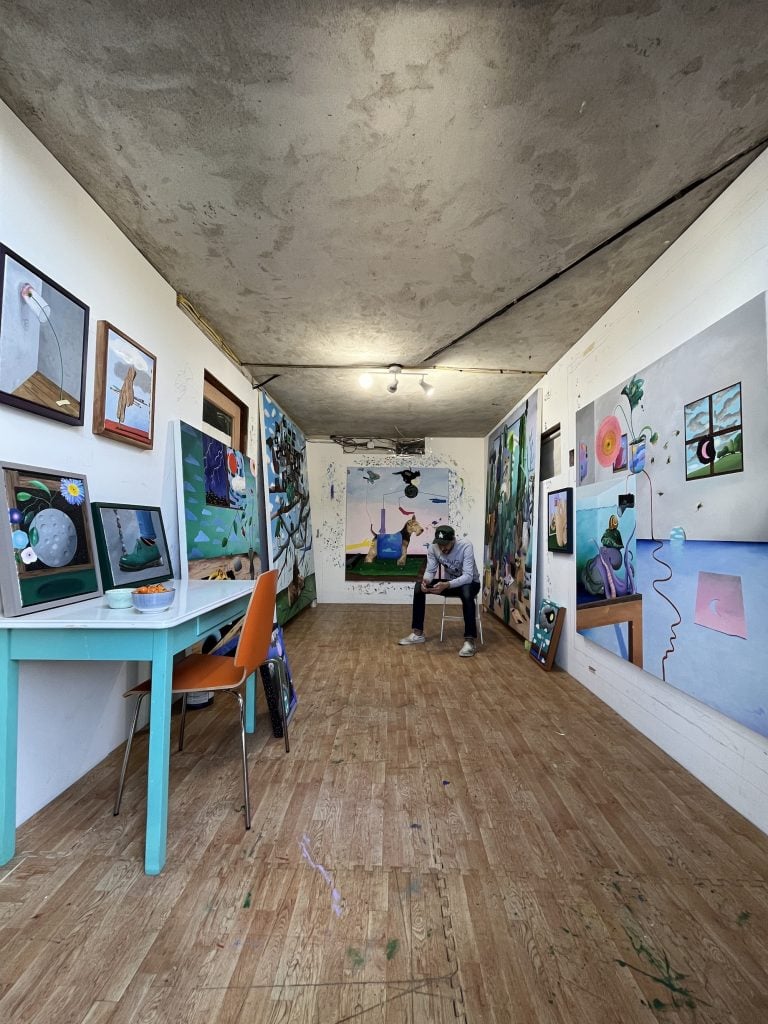
Craig Kucia in his studio. Courtesy of the artist.
What is the first thing you do when you walk into your studio (after turning on the lights)?
I sit for a while and make a list of what I want to do that day. I’ll clean up from the night before, or get my palette ready.
What is a studio task on your agenda this week that you are most looking forward to?
I’m making a couple of small paintings for a show Thea is organizing with Massey Klein in December. I’ve got to get started on a big one for the Pit’s February group show in their new space.
What tool or art supply do you enjoy working with the most, and why?
It’s probably what I don’t work with that’s a bigger deal. My dad got sick a couple of years ago, and it was probably in part because of chemicals he was exposed to at his jobs. I’ve always made an effort to be healthy, but after he died I was just done with all of that. I relearned how to paint without any spirits or any other chemicals. I’ve narrowed my practice to using oil out of the tube and paste medium. I’ve done a crazy amount of research and have eliminated my exposure to anything.
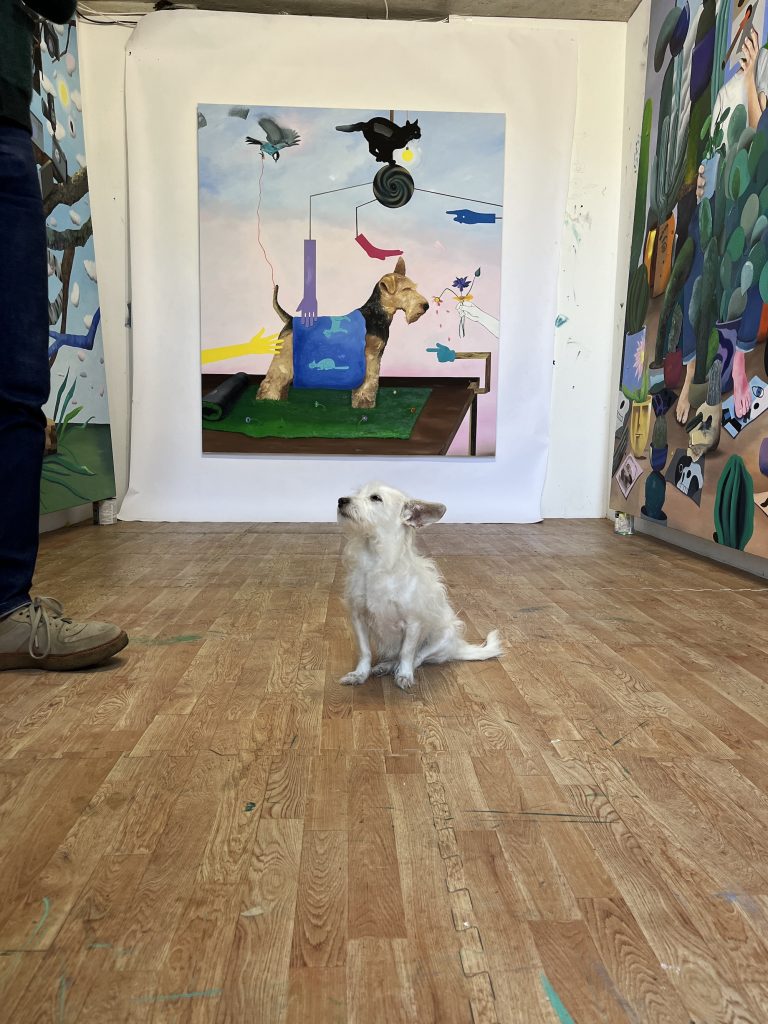
Courtesy of the artist.
What kind of atmosphere do you prefer when you work? Is there anything you like to listen to/watch/read/look at etc. while in the studio for inspiration or as ambient culture?
I like to be alone. I listen to music mostly, but depending on the season, I’ll have basketball on my iPad at night or football in the afternoon. Music is a huge part of the process for me though. It influences how I look at the world and can change how the work is going, especially if I’m having a bad day. There are days I go in there and am not really into working and a good album can change that. I go through phases, but I always come back to 90s indie rock. I think I construct paintings in the way that those songs were constructed.
How do you know when an artwork you are working on is clicking? How do you know when an artwork you are working on is a dud?
When it’s clicking it’s actually really hard to put into words. It just feels like everything is exactly as it’s supposed to be. You don’t care if it sells, you don’t care if anyone sees it, it just feels like it’s who you’re supposed to be. I used to skateboard, and it’s the same feeling. Some days your feet just land the way they’re supposed to every time. There’s a Franz Kline quote that making a painting is like hand-stuffing a mattress, which I mistook as him saying when it’s bad, it’s like painting with your hand stuck in a mattress. That’s pretty accurate.
When you feel stuck while preparing for a show, what do you do to get unstuck?
Both my parents had the kind of blue-collar jobs where you just got up and went every day. It wasn’t really about passion or inspiration. I think a lot of that has informed my studio practice. You just go every day and work till it works.
What images or objects do you look at while you work? Do you have any other artist’s work in your studio? If so, please share a phone pic and tell the story behind it.
I try to make a point of not leaving other monographs or catalogs open in the studio. I’m really trying to make something that doesn’t look like anything else and it’s hard to have that around and not let it seep in. Which isn’t to say that a lot of it isn’t in my head anyways. I have sketches and things I’ve taken pictures of.
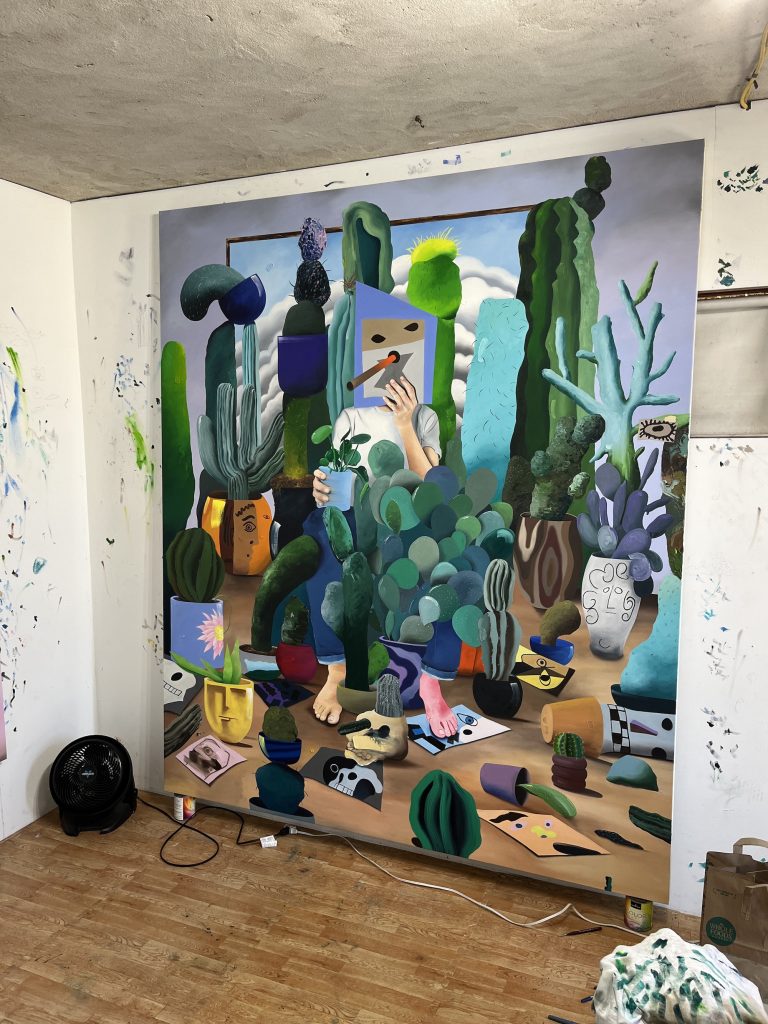
Craig Kucia in his studio. Courtesy of the artist.
What’s the last museum exhibition or gallery show you saw that really affected you and why?
The last Nicole Eisenman show at Hauser and Wirth was one of the best shows I’ve seen in a long time. I think she just nails so many of the things I’m trying to do; there are no rules. She’s tight and loose and funny and weird and historical and ambitious. She’s willing to go all out. It’s not just about making big paintings, it’s about how you’re making those big paintings.
Is there anything in your studio that a visitor might find surprising?
I think people who saw the Shrine show would be surprised by how small it is. It was really floor-to-ceiling there for a while.
What is the fanciest item in your studio? The most humble?
I like clothes and have a weird thing about looking nice just in case. I can’t paint in Crocs or sandals. My current painting jeans are A.P.C., which is probably absurd. I use the cheapest brushes on earth though because I just can’t justify spending a lot of money on a paintbrush.
How does your studio environment influence the way you work?
It’s a small space so I have to be efficient and organized about what I work on and when. There’s a lot of planning that just goes into the logistics of it. I keep it pretty neat. It also has doors that open onto my neighborhood street. I get good light and we’ve had a lot of praying mantises lately. I get to sit outside in the sun by some cactuses when I take a break. The girls usually stop in when they get home from school before going upstairs. Sometimes Ruby draws on something I’m working on and it makes its way in.
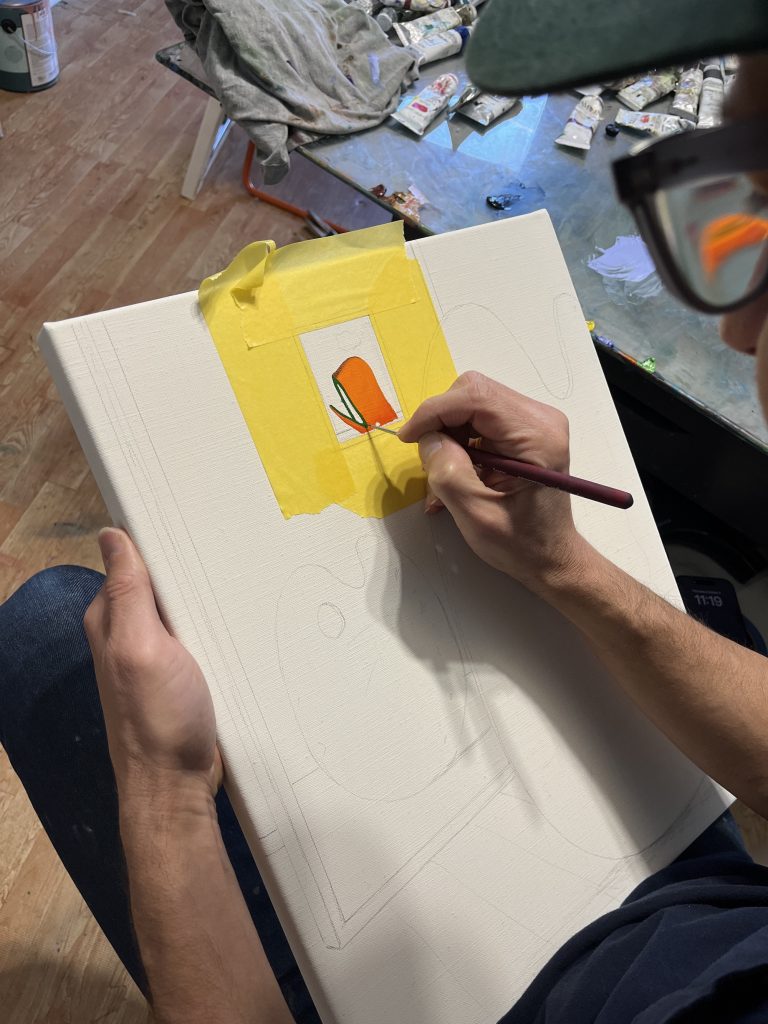
Courtesy of Craig Kucia.
What’s the last thing you do before you leave the studio at the end of the day (besides turning off the lights)?
I’ll clean my brushes and my palette. I’m kind of obsessive about checking the paintings and making sure they’re secure on the wall, especially if it’s going well. Even before I lived with earthquakes, I have the most chronic fear about something falling off the wall. Sometimes I’ll just go down and double-check before bed. I know it’s ridiculous.
What do you like to do right after that?
The girls are usually getting ready for bed when I come upstairs. We’ll do the bedtime routine, so an embarrassing number of nights my post-studio wind-down is probably a couple of episodes of Bluey and a dark stout.